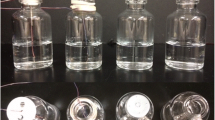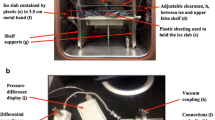Abstract
Inter- and intra-batch variability in heat and mass transfer during the drying phase of lyophilization is well recognized. Heat transfer variability between individual vials in the same batch arise from both different positions in the vial array and from variations in the bottom contour of the vials, both effects contributing roughly equally to variations in the effective heat transfer coefficient of the vials, Kv. Both effects can be measured in the laboratory, and variations in average Kv values as a function of vial position in the array for lab and production can be calculated by use of the simple steady-state heat and mass transfer theory. Typically, in the laboratory dryer, vials on the edge of the array, “edge vials,” run 2–4°C warmer than “center vials,” but differences between laboratory and manufacturing temperatures are modest. The variability in mass transfer can be assigned to major variations in ice nucleation temperature (both intra-batch and inter-batch), including major differences between laboratory and manufacturing. The net effect of all random variations, for each class of vial, can be evaluated by a simple statistical model-propagation of error, which then allows prediction of the distribution in product temperatures and drying times, and therefore prediction of percent of vials dry and percent of vials collapsed and proximity to the edge of failure for a given process. Good agreement between theoretical and experimentally determined maximum temperatures in primary drying and percent collapsed product demonstrates the calculations have useful accuracy.











Similar content being viewed by others

References
Pikal MJ. Use of laboratory data in freeze drying process design: heat and mass transfer coefficients and the computer simulation of freeze drying. J Parenteral Sci, and Tech. 1985;39:115–38.
Pikal MJ, Roy ML, Shah S. Mass and heat transfer in vial freeze drying of pharmaceuticals: role of the vial. J Pharm Sci. 1984;73:1224–37.
Roy ML, Pikal MJ. Process control in freeze drying: determination of the end point of sublimation drying by an electronic moisture sensor. J Par Sci and Tech. 1989;43:60–6.
Rambhatla S, Tchessalov S, Pikal MJ. Heat and mass transfer scale-up issues during freeze-drying, III: control and characterization of dryer differences via operational qualification tests. AAPS PharmSciTech. 2006;7(2):E61–70.
Pikal MJ, Bogner RH, Mudhivarthi V, Sharma P, Sane P. Freeze drying process development and scale-up of edge vial versus center vial heat transfer coefficients, Kv. J Pharm Sci. 2016;105(11):3304–13.
Rambhatla S, Ramot R, Bhugra C, Pikal MJ. Heat and mass transfer scale-up issues during freeze drying: control and characterization of the degree of supercooling. AAPS Pharm. Sci. Tech. 2004;5(4):54–62.
Tang X, Nail S, Pikal M. Evaluation of manometric temperature measurement (MTM), a process analytical tool for freeze drying: part III. Heat and Mass Transfer Measurement. 2006;7(4):E105–11.
Kuu WY, Hardwick LM, Akers MJ. Rapid determination of dry layer mass transfer resistance for various pharmaceutical formulations during primary drying using product temperature profiles. Int J Pharm. 2006;313(1–2):99–113.
Rob Sever, Praxair Corporation, private communication.
Randolph TW, Searles JA. Freezing and annealing phenomena in lyophilization: effects upon primary drying rate, morphology, and heterogeneity. Am Pharma Rev. 2002;5(40):42, 44–6.
Greco K, Mujat M, Galbally-Kinney KL, Hammer DX, Ferguson RD, Iftimia N, Mulhall P, Sharma P, Kessler WJ, Pikal MJ. Accurate Prediction of Collapse Temperature using Optical Coherence Tomography-Based Freeze-Drying Microscopy. J Pharm Sci 2013;102(6):1773–85.
Author information
Authors and Affiliations
Corresponding author
Additional information
Communicated by: Ajaz S. Hussain, Kenneth Morris, and Vadim J. Gurvich
Electronic supplementary material
ESM 1
(PPTX 43 kb)
Rights and permissions
About this article
Cite this article
Pikal, M.J., Pande, P., Bogner, R. et al. Impact of Natural Variations in Freeze-Drying Parameters on Product Temperature History: Application of Quasi Steady-State Heat and Mass Transfer and Simple Statistics. AAPS PharmSciTech 19, 2828–2842 (2018). https://doi.org/10.1208/s12249-018-1155-4
Received:
Accepted:
Published:
Issue Date:
DOI: https://doi.org/10.1208/s12249-018-1155-4



